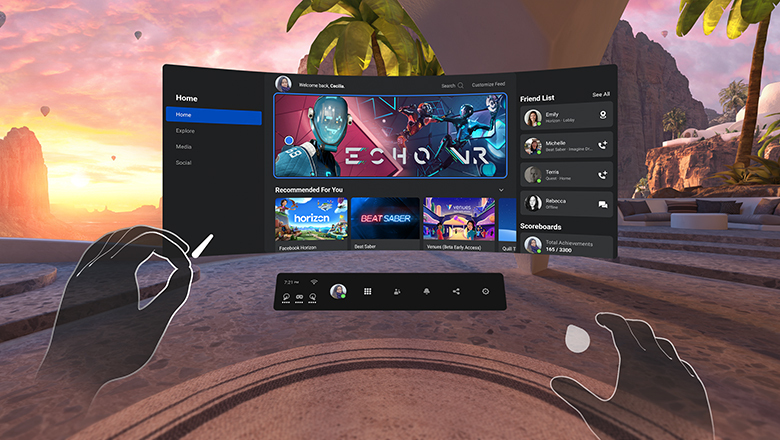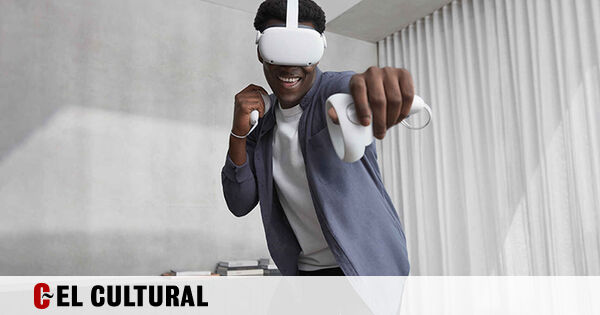In this welcome break of releases I have managed to take some time to finally get on with the Facebook virtual reality glasses: the Oculus Quest 2. After that Mark Zuckerberg bought the invention to Palmer Luckey –and after that out of the company and will leave the hands free to devote himself to the arms industry, I must say– the glasses have gone through different stages, each time tweaking different aspects to solve the many challenges they have to face the technology. After so many years and several iterations, the result is a Quest 2 with a clear purpose: bringing virtual reality closer to the masses with a very solvent product at a very competitive price.
After almost five years of almost exclusively using the PlayStation VR (and its magnificent collection of games), the jump to the Quest 2 is qualitative. Beyond the more than obvious increase in resolution and frames per second, the freedom offered by being able to play without endless cables connected to various devices solves one of the main problems that I had until now when putting on my glasses to immerse myself in virtual environments: the logistical laziness of having to have all the connections. With the push of a button, the Quest 2 are activated and make it easy for you to enter the game space in seconds. The helmet is lightweight, fits well on the head and allows you to move easily with the device on. Since there are no cables, games that require movement and some physical activity can be performed without the risk of getting unsteady due to wiring entanglement.
The technology of the Quest 2 is very different from those of the PSVR. The cameras are embedded in the glasses themselves. The first thing they ask you is to delimit a game space (called Guardian). There are two ways to do this. One is for seated play, where the glasses are limited to collecting a circular space of one meter in diameter around the player. The second is to play standing, which allows a wider range of movements. In this mode, it is necessary to indicate with one of the controllers the space through which we can move safely, keeping away from walls and furniture. Once the safe space has been marked, the glasses will warn us every time we approach the imaginary border in a dangerous way, breaking our dive but saving us at the same time from a fortuitous crash.

Being able to play without cables in virtual reality is liberating, but I would like to emphasize here the convenience of having a large gaming space. The more, the better. With ten square meters free of obstacles the experience can be satisfactory, but if there are twenty-five, much better. Some of the games require more or less forceful physical activity (for example, Beat Saber) and we will most likely lose the reference points with the real world, so the larger and more regular (a square works better than a rectangle) the space, the interruptions will be less frequent and the immersion in virtual environments, much greater. It is very common to get disoriented while playing in virtual reality, moving from the center of the space we have delimited to the sides, touching the border. These interruptions will be less frequent the more space we have, something that perhaps does not fit well with the available space of many flats in Spain. As affordable as the price of the Quest 2 is – which it is – the condition of the soil is an addition to take into account.
Another of the biggest factors where I have been able to verify a qualitative difference is in the sound, which are incorporated into the device itself, not requiring the coupling of additional headphones, with the consequent ease of use. Despite having the speakers very well camouflaged in the glasses, the entire sound aspect of the games and applications is perceived with a meridian clarity, being able to also transfer the spatial directionality of the sound effects with a three-dimensional feeling that favors immersion. Buttons on the bottom of the glasses allow quick and practical access to the volume control, so you don’t have to interrupt the session if you want to adjust it.
To get some buts out of it, I would argue that the headband that the Quest 2s use to adjust them to the head is not the most comfortable in the world, nor is it the most effective. The battery also drops with surprising rapidity, while it is more than enough for an average session of about three hours, although I guess it depends a lot on the intensity of the applications and the games. The battery of the controls, however, seems infinite, and that’s because they use batteries. After several weeks of use it does not seem that they have suffered in the slightest yet.
The Climb 2 | Launch Trailer | Oculus Quest Platform
Although the Quest 2 have enough power to render the most modest games, they also serve to take advantage of the most demanding games that require a powerful computer. Through the Oculus Link cable I have been able to try games like Asgard’s Wrath and Medal of Honor: Above and Beyond, the closest thing to the traditional blockbusters that we can find in the field of virtual reality. The result has been very satisfactory, although having a cable connected denatured the proposal a little. However, even in this aspect there is good news because Oculus engineers have managed to implement a Wifi streaming mode that solves many of the technical problems that required the ultrafast data transmission of the cable until now. I haven’t been able to test it in depth yet, but it does manage to completely do without the cable to connect to the computer and is capable of transmitting data at a certain distance (ten or fifteen meters).
Oculus Quest 2 is a big step forward in the narrow path of virtual reality due to the incredible technology they have managed to implement in the reduced weight and space of the glasses at such a competitive price. It is very unlikely that VR experiences will replace traditional ones, but it would be a very serious mistake to despise them for this. In many respects, virtual reality is a paradigm shift, opening up new horizons for creators, who have to invent a new vocabulary in a language that is still in its infancy. One of the experiences I have enjoyed the most has been The Climb 2, the Crytek proposal that invites us to climb through incredible natural and urban environments. With simple mechanics and some resulting graphics, although modest, it manages to convey the feeling of vertigo and euphoria that I imagine those who dedicate themselves to this risky sport have to feel. It is something that will surely arouse the curiosity of many more than those who finally dare to climb a wall in a massif in the Alps or a cliff in Thailand. Virtual reality allows us to vicariously experience activities that, for more than obvious reasons, are forbidden to the majority. I can’t wait to see what it all ends up turning into, when the photorealistic graphics that we can see on the latest generation consoles can be implemented in virtual reality. Ads of the event that Oculus just to show (among which stand out the version VR Resident Evil 4) point the way Facebook wants to go, the possibilities that will go to the technology, and how much you have to contribute to humanity, even beyond video games, which is what I’m concerned, but by far the more important it is.









